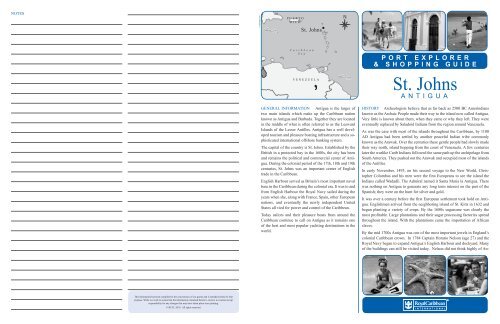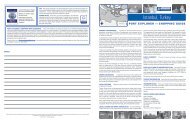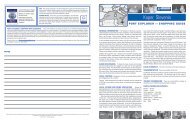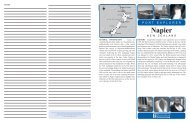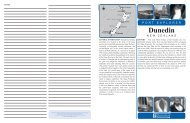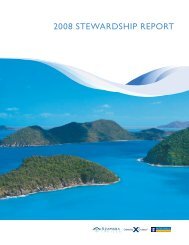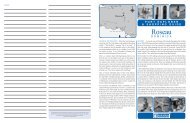St Johns
SHOPPING GUIDE - Royal Caribbean
SHOPPING GUIDE - Royal Caribbean
- No tags were found...
Create successful ePaper yourself
Turn your PDF publications into a flip-book with our unique Google optimized e-Paper software.
NOTES<br />
© 2010 maps.com<br />
P U E RT O<br />
R I C O<br />
<strong>St</strong>. <strong>Johns</strong><br />
C a r i b b e a n<br />
S e a<br />
PORT EXPLORER<br />
& SHOPPING GUIDE<br />
V E N E Z U E L A<br />
<strong>St</strong>. <strong>Johns</strong><br />
ANTIGUA<br />
GENERAL INFORMATION Antigua is the larger of<br />
two main islands which make up the Caribbean nation<br />
known as Antigua and Barbuda. Together they are located<br />
in the middle of what is often referred to as the Leeward<br />
Islands of the Lesser Antilles. Antigua has a well developed<br />
tourism and pleasure boating infrastructure and a sophisticated<br />
international offshore banking system.<br />
The capital of the country is <strong>St</strong>. <strong>Johns</strong>. Established by the<br />
British in a protected bay in the 1600s, the city has been<br />
and remains the political and commercial center of Antigua.<br />
During the colonial period of the 17th, 18th and 19th<br />
centuries, <strong>St</strong>. <strong>Johns</strong> was an important center of English<br />
trade in the Caribbean.<br />
English Harbour served as Britain’s most important naval<br />
base in the Caribbean during the colonial era. It was to and<br />
from English Harbour the Royal Navy sailed during the<br />
years when she, along with France, Spain, other European<br />
nations, and eventually the newly independent United<br />
<strong>St</strong>ates all vied for power and control of the Caribbean.<br />
Today sailors and their pleasure boats from around the<br />
Caribbean continue to call on Antigua as it remains one<br />
of the best and most popular yachting destinations in the<br />
world.<br />
History Archeologists believe that as far back as 2500 BC Amerindians<br />
known as the Archaic People made their way to the island now called Antigua.<br />
Very little is known about them, when they came or why they left. They were<br />
eventually replaced by Saladoid Indians from the region around Venezuela.<br />
As was the case with most of the islands throughout the Caribbean, by 1100<br />
AD Antigua had been settled by another peaceful Indian tribe commonly<br />
known as the Arawak. Over the centuries these gentle people had slowly made<br />
their way north, island hopping from the coast of Venezuela. A few centuries<br />
later the warlike Carib Indians followed the same path up the archipelago from<br />
South America. They pushed out the Arawak and occupied most of the islands<br />
of the Antilles.<br />
In early November, 1493, on his second voyage to the New World, Christopher<br />
Columbus and his men were the first Europeans to see the island the<br />
Indians called Wadadli. The Admiral named it Santa Maria la Antigua. There<br />
was nothing on Antigua to generate any long term interest on the part of the<br />
Spanish; they were on the hunt for silver and gold.<br />
It was over a century before the first European settlement took hold on Antigua.<br />
Englishmen arrived from the neighboring island of <strong>St</strong>. Kitts in 1632 and<br />
began planting a variety of crops. By the 1680s sugarcane was clearly the<br />
most profitable. Large plantations and their sugar processing factories spread<br />
throughout the island. With the plantations came the importation of African<br />
slaves.<br />
By the mid 1700s Antigua was one of the most important jewels in England’s<br />
colonial Caribbean crown. In 1784 Captain Horatio Nelson (age 27) and the<br />
Royal Navy began to expand Antigua’s English Harbour and dockyard. Many<br />
of the buildings can still be visited today. Nelson did not think highly of An-<br />
This information has been compiled for the convenience of our guests and is intended solely for that<br />
purpose. While we work to ensure that the information contained herein is correct, we cannot accept<br />
responsibility for any changes that may have taken place since printing.<br />
© RCCL 2010. All rights reserved.
tigua. “I should almost hang myself at this infernal hole.” He chose<br />
to spend most of his time aboard his 28-gun frigate HMS Boreas. As<br />
disgusting as Nelson found Antigua, the British merchants and traders<br />
of the island together with those throughout England’s Caribbean<br />
colonies found the young captain equally abhorrent. By following<br />
official orders Nelson was cutting into their profits. Those orders were<br />
for Nelson to enforce Parliament’s Act of Navigation. This law stated<br />
England’s Caribbean ports could only trade with English ships. But<br />
American merchant ships dominated Caribbean trade and America was<br />
no longer an English colony. Captain Nelson may have done a great<br />
deal for the maritime and military infrastructure of Antigua but British<br />
merchants throughout the Caribbean wanted him arrested and thrown<br />
1<br />
in the brig and sued for their loss of profits in American trade.<br />
In 1834 African slaves in the British islands of the Caribbean were<br />
freed. On Antigua, rather than instituting a workable transition, emancipation<br />
took place virtually over night. In reality little changed. Most<br />
of the former slaves had little economic choice but to continue to work<br />
for their former masters under many of the same deplorable conditions.<br />
As the price of sugar rose or fell over the centuries, the economy<br />
of the island, as well as the merchants, planters and freed slaves alike,<br />
experienced numerous difficulties.<br />
On November 1, 1981 Antigua and Barbuda gained full independence<br />
from The United Kingdom.<br />
2<br />
3<br />
© 2010 maps.com<br />
naval history. It is amazing not only for the brick and mortar, but as<br />
much for the centuries old graffiti. Names carved in wood or scratched<br />
in stone representing a fleeting moment in the lives of so many young<br />
sailors are still visible to this day.<br />
During its day it was known as “His Majesty’s Antigua Naval Yard”.<br />
Since restoration began in the 1950s it has been called “Nelson’s<br />
Dockyard” in honor of the British sailor most famously associated<br />
with English Harbour, the empire’s greatest naval hero; Admiral Lord<br />
Viscount Horatio Nelson. Today, while accommodating the interests<br />
of visitors (inns, cafes and shops) and needs of pleasure boats (repairs<br />
and respite), the site has been respectfully restored. Some of the primary<br />
buildings include:<br />
The Naval Officers House (1855) is the location of the dockyard’s<br />
museum. The museum tells the history of English Harbour and includes<br />
a number of items once belonging to Vice Admiral Horatio<br />
Nelson; a Captain during his time here in Antigua.<br />
The Pillars (1797) are all which remain of the Boat House & Joiners<br />
Loft. This is where England’s giant ships-of-the-line had their massive<br />
sails repaired or replaced.<br />
The Copper & Lumber <strong>St</strong>ore (1789) was the workshop for the<br />
craftsmen who applied the copper to the hulls of the ships and the<br />
storage facility and workshop for carpenters responsible for the large<br />
imported timber beams and planks.<br />
The Cordage and Canvas <strong>St</strong>ore housed the work areas, ropes and<br />
raw materials used by the ships’ enormous propulsion systems - canvas<br />
sails.<br />
The Pitch and Tar <strong>St</strong>ore (1788) was the location for preparation and<br />
boiling the sealant for the ships’ hulls. It seems the base engineer’s<br />
office may have been on the second floor of the building. If this is<br />
accurate it adds credence to the fact that British sailors regarded their<br />
time stationed in English Harbour as “punishment”.<br />
The Seaman’s Gallery was where the sailors were fed while on shore.<br />
The men most likely ate a stunningly monotonous diet of salt-beef<br />
(corned beef), cheese (likely hard as a rock) and bread. Locally grown<br />
fruit may have supplemented their otherwise bland diet.<br />
Fort Berkeley and Shirley Heights are two fortifications built to<br />
guard the harbor from French or Spanish attack.<br />
3<br />
Betty’s Hope Plantation was the first large scale operation on<br />
the island. A stone windmill has been fully restored. The small<br />
museum in the former cotton storehouse relates the story of plantation<br />
life during the British colonial period.<br />
Local Cuisine and Drink Specialties As is common<br />
throughout the many islands of the Caribbean the traditional cuisine of<br />
Antigua is a combination of West Indian, French and West African. International<br />
cuisine can be found in the Antigua’s many restaurants and<br />
cafes. Dukuna is a dumpling made from a mixture of flour, sweet potatoes<br />
and spices then steamed. Chicken <strong>St</strong>ew is often marinated with<br />
chilies, lemon juice, garlic and vinegar then added to sautéed garlic,<br />
thyme, coriander and onions. Vegetables, spicy Créole hot sauce and<br />
water are added then covered and simmered. It is usually served on<br />
a bed of white rice. Papayas Pie combines crushed fruit, egg whites,<br />
flour and sugar, lime zest and juice and cinnamon. Conch Fritters are<br />
a mixture of chopped conch meat, celery, cloves, garlic, eggs, onion,<br />
green pepper, milk and flour rolled into bite size balls, deep fried then<br />
splashed with your favorite hot sauce.<br />
Rum has been produced in Antigua since the early 1800s. Distillers<br />
say the rum now served is much different (this means better) from the<br />
rum produced two centuries ago. Today English Harbour 5 Year Old<br />
Antigua Rum is reputed to be one of the best in the Caribbean. It is<br />
produced by The Antigua Rum Distillery, the only remaining distillery<br />
on the island.<br />
Shopping The main centers for shopping in <strong>St</strong>. <strong>Johns</strong> are the duty<br />
free shopping areas of Heritage Quay and Redcliffe Quay.<br />
Local Currency The official currency on Antigua is the East<br />
Caribbean dollar. U.S. dollars and major credit cards are widely accepted.<br />
Post Office AND TELEPHONE FACILITIES There is a Post<br />
office at the end of Long <strong>St</strong>reet in <strong>St</strong> <strong>Johns</strong>, opposite the supermarket.<br />
There is also a Post Office in Nelson’s Dockyard.<br />
Dial the following access numbers to use a personal calling card from<br />
a public phone:<br />
AT&T: 1.800.225.5288<br />
MCI: 1.800.888.8000<br />
Tourist Information There is a Tourist Office and Bank in<br />
Nelson’s Dockyard.<br />
Transportation Rental cars are available and taxis are plentiful.<br />
Determine a fare prior to departure.<br />
Language English is the official language of Antigua.<br />
ANTIGUA PLACEs of Interest<br />
1<br />
<strong>St</strong> <strong>Johns</strong> is the capital of Antigua. It has numerous shops and<br />
restaurants. The Museum of Antigua & Barbuda is located in the<br />
city. Fortifications in the surrounding area include: Fort James, Fort<br />
Barrington, Fort George, Fort Shirley and Fort Charles.<br />
2<br />
English Harbour was homeport for Britain’s Squadron of the<br />
Leeward Islands during the 18th and 19th centuries. Great ships<br />
of the Royal Navy called here for refitting and repair as they battled<br />
with the French and Spanish for dominance in the Caribbean. Many of<br />
PLACES OF INTEREST<br />
the highly skilled craftsmen were African slaves. Their British counterparts;<br />
the caulkers, blacksmiths, shipwrights and sail makers were,<br />
like most of the young sailors themselves, also pressed into service<br />
for the Royal Navy. For the British sailors and officers, assignment to<br />
this base was extremely demanding. Disease and death at an early age<br />
was common.<br />
When the Royal Navy eventually pulled out of English Harbour in the<br />
late 1800s the entire facility slowly deteriorated due to storms, quakes,<br />
neglect and the ravages of time. This is an amazing site of British<br />
Shore Excursions To make the most of your visit to <strong>St</strong>. <strong>Johns</strong><br />
and the surrounding area we suggest you take one of our organized<br />
Shore Excursions. For information concerning tour content and pricing,<br />
consult your Shore Excursion Brochure or contact the Shore Excursion<br />
Desk. When going ashore, be advised to take only necessary<br />
items and secure any valuables onboard.<br />
Local Customs<br />
Bargaining: Prices are generally fixed.<br />
Tipping: Some restaurants may add a 10-15% service charge. The<br />
same percentage is appropriate for taxis.


